Growing grapes for beginners
Grapes are among the first plants that humans began to cultivate. It was grown by the ancient Romans and Egyptians. Now it is popular all over the world. The grapes grow successfully both in the southern climate and in the central regions. If in the first case it is possible to grow varieties with large, delicious fruits, then only hardy varieties with small berries that have a dense skin and a tart taste can cope with a cool climate.
The technology of growing grapes, especially in temperate climates, has a number of nuances. In order to get rich harvests every year and not lose plants during winter frosts, it is important to know how to care for them. However, if you understand all the intricacies and follow the instructions, even a novice gardener can create his own vineyard.
Features of grape growth
It will be easier for beginners to understand the principles of viticulture if you understand the characteristics of plant growth. This will allow you to understand what care the shrub needs at different times of the year.
The lifespan of grapes depends on its variety and method of propagation. Thus, wild specimens grown from seeds are capable of growing and bearing fruit for more than 400 years. Plants grown vegetatively continue to bear fruit for 25 to 150 years.
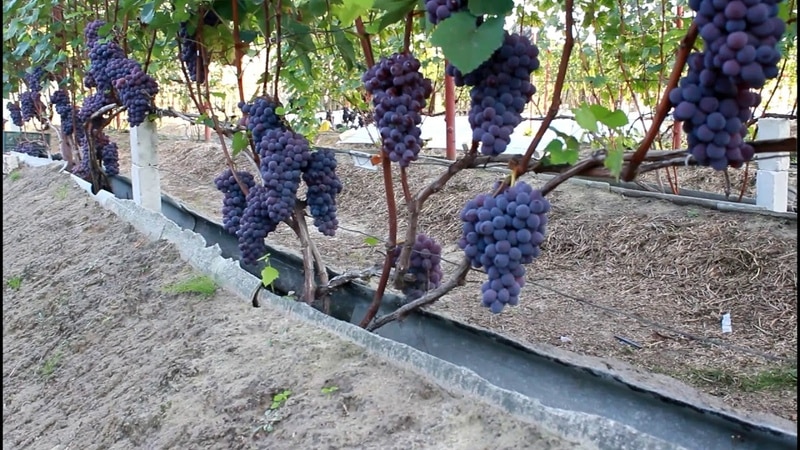
How quickly the plant begins to bear fruit also depends on the growing method. With the seed planting method, the plant produces fruits 5-6 years after planting. When growing grapes from cuttings The first harvest will be harvested in 2-3 years.When using layering and grafting, berries will appear in the first year.
From the germination of the grape seed to the end of the growing season, the plant goes through a long development cycle, which is divided into stages:
- Height. The shortest period, the duration of which ranges from 1 year to 5 years. At this time, the plant is developing, preparing for fruiting.
- Development and fruiting. The longest period. It lasts longer than 25 years.
- Weakening of productive and growth function. This is expressed in the absence of new shoots and an increase in the size of the plant, a gradual decrease in yield, up to the complete absence of fruits.
During their life, grapes go through a small cycle that repeats annually. It consists of a dormant and vegetative phase.
Rest phase occurs in shrubs only in regions with severe winter cold snaps. During this period, leaf fall is observed. Young shoots ripen, acquiring a dark color. Unripe parts of the plant fall off. Several layers near the core, as well as the bark of the root system, are converted into cork tissue, protecting the living parts of the plant from frost. Growth stops. All life processes in plant tissues slow down or stop.
Second phase – growing season. It lasts from the beginning of spring to the end of autumn. At this time, the grapes are actively growing, throwing out new shoots, blooming and bearing fruit. It is during this period that the plant requires increased attention and care.
Growing methods
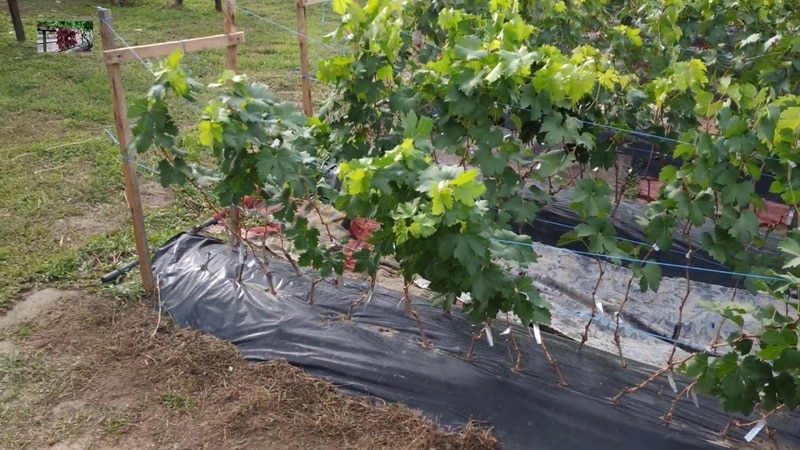
Grapes are grown throughout Russia, except the Far North. There are varieties that not only produce fruit, but also perform a decorative function. Some of them can be grown at home.
Methods of growing grapes:
- In open ground. This is the most common option for breeding crops. Only those plants that can grow in a particular region should be planted in open ground.
- Greenhouse. Grapes are grown in greenhouses in central and northern Russia. This method of cultivation makes it possible to cultivate varieties with delicious berries, such as sultanas, in harsh climatic conditions.
- On the balcony. There are decorative grape varieties that have small sour berries, but beautiful leaves and shoots. They are unpretentious and are used not only in landscape design, but also for decorating balconies.
- On the windowsill. There are varieties that can be grown at home in a flower pot. They also have a decorative function.
Selecting a grape variety
When choosing a variety to grow for different years in Russia (for example, for the Moscow region and Krasnodar Territory), it is important to pay attention to the following factors.
- immunity;
- maximum frost resistance;
- productivity;
- growing conditions;
- demands on soil;
- taste qualities;
- size and color of berries;
- presence of drought resistance.
Landing
Planting and caring for grapes requires compliance with basic rules. Only in this case will it be possible to grow strong, healthy plants.
To propagate grapes, the cutting method is most often used. It allows you to get the first harvest within 2 years after planting. Reproduction by layering is used less frequently.
Grapes can be planted in spring (from mid-March to early June) and autumn. The first option is more preferable, especially for regions with a cool climate - there is a higher chance that the seedling will take root.
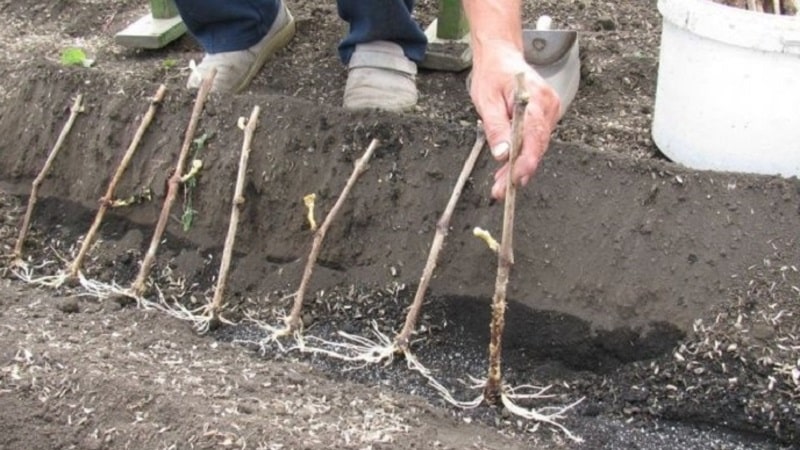
Selection and preparation of planting material
An important condition for growing grapes is the selection of suitable planting material and its preparation. It is these stages that will determine whether the seedling will take root and how often the plant will get sick in the future.
Usually seedlings are bought in specialized stores and markets. To choose the best planting material, pay attention to the following factors:
- Roots. A good seedling should have more than 4 thick roots. A well-developed root system will allow planting material to take root faster. The roots should be long, dense and thick. When cut, the root should be white and moist. Dry, limp, thin and broken roots indicate poor product quality. The chances that such planting material will take root are slim.
- Trunk. The main thing is that there are at least 5 living buds on it. To make sure that the kidneys have not died, they are pressed with a finger. If the buds begin to peel or fall off, they are not viable. There should be no damage or signs of disease on the vine. A high-quality barrel is elastic and warm to the touch. Its bark is brown, with a layer of green underneath.
- Number of trunks. One seedling should have no more than 2 trunks. 2 vines will take root if the planting material has a developed root system.
- Size of vines. The diameter of the trunk should not be less than 6 mm. The length should vary between 30-40 cm.
Grape seedlings are also called chubuki. You can prepare them yourself, during the process of forming the vine.
Advice! It is recommended to buy chibouks in the fall. They are stored until spring, buried in trenches or in boxes with sand.
So that the plants do not get sick and quickly take root, they are prepared for planting. This is done as follows:
- The seedling is shortened on each side by 1.5 cm. The cuts are made at an angle. This procedure activates the growth of the seedling.
- To protect grapes from diseases, planting material is disinfected. To do this, it is immersed for 20 minutes in a light pink solution of potassium permanganate at room temperature.
- For 2 days, the chibouks are soaked in a solution of a growth stimulator (Epin, Circo). This will increase the resistance of seedlings to negative environmental factors and help them take root faster.
I prepare the seedlings immediately before planting.
Selection, site preparation and planting
To grow grapes, it is important to choose a suitable place in the garden. It should be protected from the wind and located in the most illuminated area. Groundwater should not be close to the surface. It is desirable that the beds have no slope.
Experienced gardeners recommend placing grape beds in the southwest. The grape rows are arranged from north to south. However, this is not necessary. Any location that meets these requirements will do.
The site is prepared at least 3 weeks before planting the seedlings. If grapes are planted in the spring, it is recommended to prepare the site in the fall. This is done this way:
- Dig holes. In sandy soil its depth should be 50 cm, and in clay soil 20 cm.
- The soil from the hole is mixed with fertilizers. For 1 part of the soil take 1 part of rotted manure, 25 g of superphosphate, 1 tbsp of ash.
- Drainage is poured into the bottom of the hole. This can be small crushed stone, expanded clay or broken ceramics. A layer of branches or boards is placed on the drainage.
- On top of the layer of branches, make a mound of prepared soil mixture.
- The roots are dipped into a mixture of clay and mullein. To do this, pour 1 kg of mullein and 2 kg of clay into a bucket. The rest of the volume is filled with water.All ingredients are mixed to obtain a mixture with a uniform consistency.
- Escapes trimmed 1-2 cm and dipped into molten paraffin.
- The seedling is placed in the hole so that the vine is in the center of the hill. The roots must be laid out around the mound.
- The hole is filled with the remaining soil. The soil around the seedling is crushed.
- The grapes are watered. For one plant use 5 liters of settled water at room temperature.
- The soil around the grapes is mulched. It is covered with compost, fallen leaves, rotted straw or peat.
Grape care
When wondering how to properly grow grapes, you should first familiarize yourself with the basic nuances of caring for them. The life expectancy and productivity of the plant depend on the correct agricultural technology.
Rules for planting and caring for grapes in open ground for beginners.
Care after winter
When the outside temperature reaches +5°C, remove from the plant shelter. The bush is sprayed with Epin. The grapes are inspected for diseases and sprayed with a solution of copper sulfate (take 1 tbsp of the product per bucket of water).
Preparing for winter
To prevent infection of grapes with infectious diseases, it process copper sulfate solution. Collect all leaves and plant debris. The vine is bent to the ground and secured with a weight or bracket. The top of the plant is covered with spruce branches.
in winter
In winter, it is recommended to sprinkle the grape plantings with snow.
Watering
The grapes do not need frequent watering. The soil is watered for the first time after it has been harvested. winter shelter. The plantings are watered for the second time 7 days before flowering, and the third time when the plant has finished flowering.
The grapes are watered for the last time during the season when all the fruits have been harvested. For irrigation, use warm, settled water. This procedure is carried out in the morning or evening, when the sun is inactive.
Garter

The procedure is carried out in 2 stages. Dry gartering is carried out immediately after the winter shelter is removed. The vine is tied to the first step of the trellis. The green garter is made as the shoots develop. The regrown parts of the plant are attached to the next steps of the shoots at an angle.
Loosening
After each watering and precipitation, the soil around the grapes is loosened to destroy the earthen crust. During the loosening process, it is convenient to remove weeds that carry infection.
Preventative treatments
When grapes are growing, it is important to protect them from diseases. For this purpose, preventive treatment is carried out. The plant is sprayed for the first time in the spring, the second time a week before flowering or on the buds, the third time after flowering, the fourth time when the fruits reach the size of peas.
For spraying, use Bordeaux mixture, copper sulfate or systemic fungicides.
Feeding
Before growing grapes, you should familiarize yourself with the fertilizer application schedule. In poor soil, the plant will not please the gardener with rich harvests and will get sick.
Before the first fruiting (2-3) years, the grapes are not fed. It has enough nutrients added during planting. Therefore, it is so important to lay a sufficient amount of rotted manure and mineral fertilizers before planting a seedling.
After the grapes begin to bear fruit, fertilizing becomes necessary. The plant is fertilized at the root according to the following scheme:
- First feeding Apply immediately after harvesting the winter covering. Use granular dry fertilizers.For one plant take 40 g of superphosphate, 45 g of nitrogen fertilizer and 30 g of a preparation containing potassium. The substances are placed in a groove around the bush, after which the depression is filled.
- Second time Fertilizers are applied a week before flowering. To prepare, mix 2 parts water with 1 part chicken manure. The product is allowed to brew for 2 weeks, then diluted with water in a ratio of 1:5. 25 g of superphosphate and 10 g of potassium fertilizer are poured into a bucket of the resulting fertilizer. 10 liters of fertilizer are used per bush.
- During the ripening of the berries, do 3 feedings. 20 g of potassium fertilizer and 50 g of superphosphate are applied under the bush.
In spring and autumn, foliar feeding is used. The grapes are sprayed with a composition that includes microelements, which must include boron, potassium, phosphorus and nitrogen. You prepare the fertilizer yourself or buy ready-made preparations.
Shaping and trimming
The formation of young plants is quite simple. It includes two stages. Sanitary pruning is done in the fall immediately after harvesting.. Weak shoots, tops, fruit-bearing links, dry branches, parts of the plant with signs of infection or pests are removed from the bush.
The second pruning is done after leaf fall. Cut off all excess shoots, leaving on the plant from 3 to 8 sleeves located at an angle.
Those who think that pruning grapes is a quick process are mistaken. The older the plant, the longer it takes to form.
In adult grapes, during the first pruning, all shoots located below 0.5 m from the ground are cut out. All stepsons are also removed from branches located above 0.8 m from the ground surface. The tops of these branches are cut off, retreating 10 cm from the end.
During the second pruning, only perpendicular trunks and sleeves with buds located perpendicular to the soil are left. Next year, clusters of berries will grow from the latter.
Important! The first frosts harden the grapes. Pruning can be done down to –3°C.
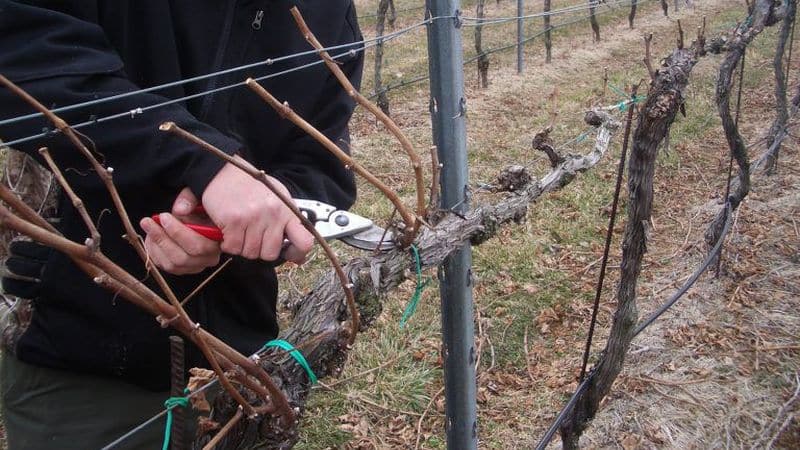
Features of cultivation in different regions
If you choose the right grape variety for a specific region, plant care will not differ depending on climatic conditions. It is not possible to grow crops in open ground in all Russian cities.
The Krasnodar region has ideal conditions for vineyards. The climate here is warm, and winter frosts rarely reach even –20°C. Therefore, in the southern part of Russia it is possible to grow varieties with large fruits, a thin shell and a sweet taste.
In Nizhny Novgorod, the Moscow region and other central regions, winters can be severe. Most cultivated grape varieties cannot grow in such conditions. Grapes with increased frost resistance are suitable for such cities. In most cases, its fruits are small in size, have a dense peel and a tart, sour taste. They are often used in winemaking.
In Siberia and other cities with cold climates, grapes do not grow in open ground. Here it is possible to grow crops only in greenhouses.
Harvesting
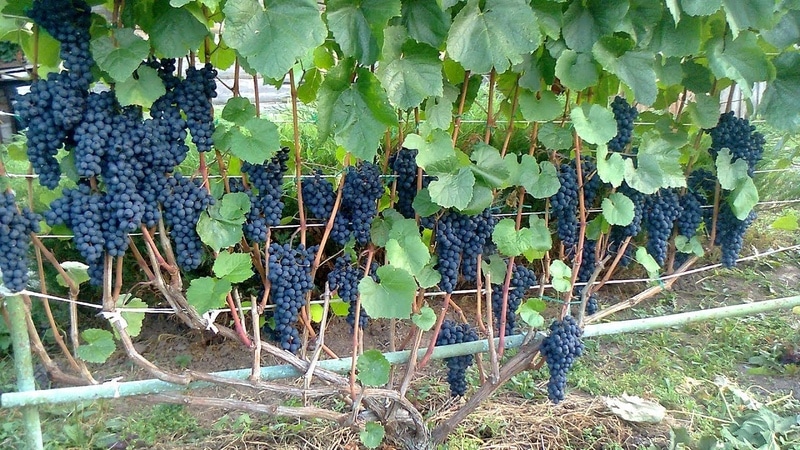
The grape harvest is harvested in the second half of summer. By this time, black berries acquire a characteristic blue color, and white ones acquire a yellowish tint. Ripe berries have juicy tender pulp, sweet taste and pronounced aroma.
The grapes are cut or broken off in whole bunches. They are stored in the refrigerator, in the vegetable drawer.
Conclusion
Grapes are a demanding crop that requires constant attention from the gardener. Without timely watering, pruning, staking, fertilizing and preparation for the winter, the plant will suffer and produce meager harvests.
The main rule for a novice winegrower is not to neglect the basic rules of care, and to listen to the advice and recommendations of experienced gardeners.